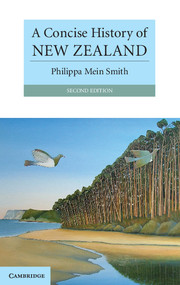Book contents
- Frontmatter
- Contents
- Illustrations
- Acknowledgements
- Preface
- 1 Waka across a watery world
- 2 Beachcrossers 1769–1839
- 3 Claiming the land 1840–1860
- 4 Remoter Australasia 1861–1890
- 5 Managing globalisation 1891–1913
- 6 ‘All flesh is as grass’ 1914–1929
- 7 Making New Zealand 1930–1949
- 8 Golden weather 1950–1972
- 9 Latest experiments 1973–1996
- 10 Treaty revival 1973–1999
- 11 Shaky ground
- Glossary Of maori words
- Timeline
- Sources of Quotations
- Guide to Further Reading
- Index
4 - Remoter Australasia 1861–1890
Published online by Cambridge University Press: 05 October 2013
- Frontmatter
- Contents
- Illustrations
- Acknowledgements
- Preface
- 1 Waka across a watery world
- 2 Beachcrossers 1769–1839
- 3 Claiming the land 1840–1860
- 4 Remoter Australasia 1861–1890
- 5 Managing globalisation 1891–1913
- 6 ‘All flesh is as grass’ 1914–1929
- 7 Making New Zealand 1930–1949
- 8 Golden weather 1950–1972
- 9 Latest experiments 1973–1996
- 10 Treaty revival 1973–1999
- 11 Shaky ground
- Glossary Of maori words
- Timeline
- Sources of Quotations
- Guide to Further Reading
- Index
Summary
If the Governor's decision to wage war in Taranaki over Waitara in 1860 was heavy-handed and aggressive, the invasion of the Waikato launched by Sir George Grey in July 1863 amounted to a blatant lunge for power. Indeed – as a narrow victory of numbers – it presaged the takeover by settler New Zealand that deluged Maori. From the 1860s the scales of power tipped to the settler society. Within a generation, Maori shrank from being the majority of the population to a small minority. The amount of land in Maori ownership, already much diminished, halved between 1860 and 1891. But pockets of Maori resistance nurtured a proud legacy that would recalibrate relations a century and more later.
New Zealand wars
Thanks to James Belich's revisionist scholarship, the New Zealand wars have come to be seen as instances of British ‘small wars’ of imperial conquest that invaded autonomous Maori sovereignty, played a significant part in defining Pakeha and Maori as ‘us’ and ‘them’, and created the national debt. Maori resistance was effective rather than futile until numbers overwhelmed them. ‘New Zealand wars’ can be used to include a first phase of significant battles in the Bay of Islands through 1845 into 1846 – the northern war – as well as clashes on both sides of Cook Strait from 1843 to 1847, notably at Wairau in Marlborough. But the wars proper raged from 1860 to 1872 across the central North Island, after a decade of peace. There is vigorous debate about the nature and legacy of these conflicts, fought over land and sovereignty and begun by the government. Power, propinquity and possession decreed that war would flare in the North Island, where tribes still owned most of the land in the 1860s. Most Maori lived in the North Island, which remained under tribal control outside the isolated coastal towns. By contrast, the South Island was, legally, already in settler hands. That left Ngai Tahu the long task of fighting their claim on paper and later in parliament.
- Type
- Chapter
- Information
- A Concise History of New Zealand , pp. 72 - 99Publisher: Cambridge University PressPrint publication year: 2011



